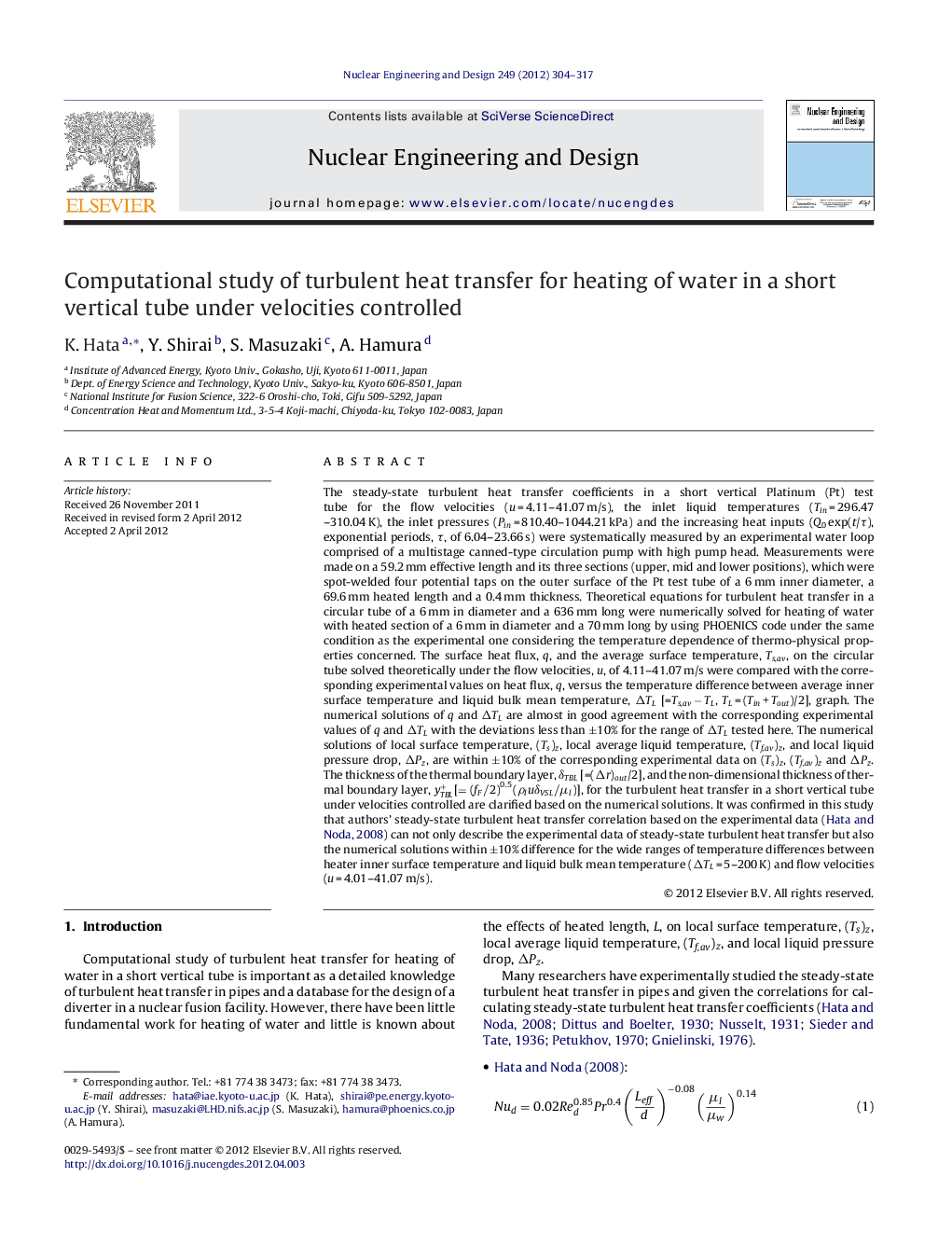| کد مقاله | کد نشریه | سال انتشار | مقاله انگلیسی | نسخه تمام متن |
|---|---|---|---|---|
| 297192 | 511750 | 2012 | 14 صفحه PDF | دانلود رایگان |

The steady-state turbulent heat transfer coefficients in a short vertical Platinum (Pt) test tube for the flow velocities (u = 4.11–41.07 m/s), the inlet liquid temperatures (Tin = 296.47–310.04 K), the inlet pressures (Pin = 810.40–1044.21 kPa) and the increasing heat inputs (Q0 exp(t/τ), exponential periods, τ, of 6.04–23.66 s) were systematically measured by an experimental water loop comprised of a multistage canned-type circulation pump with high pump head. Measurements were made on a 59.2 mm effective length and its three sections (upper, mid and lower positions), which were spot-welded four potential taps on the outer surface of the Pt test tube of a 6 mm inner diameter, a 69.6 mm heated length and a 0.4 mm thickness. Theoretical equations for turbulent heat transfer in a circular tube of a 6 mm in diameter and a 636 mm long were numerically solved for heating of water with heated section of a 6 mm in diameter and a 70 mm long by using PHOENICS code under the same condition as the experimental one considering the temperature dependence of thermo-physical properties concerned. The surface heat flux, q, and the average surface temperature, Ts,av, on the circular tube solved theoretically under the flow velocities, u, of 4.11–41.07 m/s were compared with the corresponding experimental values on heat flux, q, versus the temperature difference between average inner surface temperature and liquid bulk mean temperature, ΔTL [=Ts,av − TL, TL = (Tin + Tout)/2], graph. The numerical solutions of q and ΔTL are almost in good agreement with the corresponding experimental values of q and ΔTL with the deviations less than ±10% for the range of ΔTL tested here. The numerical solutions of local surface temperature, (Ts)z, local average liquid temperature, (Tf,av)z, and local liquid pressure drop, ΔPz, are within ±10% of the corresponding experimental data on (Ts)z, (Tf,av)z and ΔPz. The thickness of the thermal boundary layer, δTBL [=(Δr)out/2], and the non-dimensional thickness of thermal boundary layer, yTBL+[=(fF/2)0.5(ρluδVSL/μl)], for the turbulent heat transfer in a short vertical tube under velocities controlled are clarified based on the numerical solutions. It was confirmed in this study that authors’ steady-state turbulent heat transfer correlation based on the experimental data (Hata and Noda, 2008) can not only describe the experimental data of steady-state turbulent heat transfer but also the numerical solutions within ±10% difference for the wide ranges of temperature differences between heater inner surface temperature and liquid bulk mean temperature (ΔTL = 5–200 K) and flow velocities (u = 4.01–41.07 m/s).
► Measure systematically steady-state turbulent heat transfer coefficients.
► Use Pt pipe of a 6 mm inner diameter under flow velocity ranging from 4 to 41 m/s.
► Solve numerically turbulent heat transfer.
► Numerical solutions are in good agreement with experimental data.
► Clarify thickness of thermal boundary layer in pipe.
Journal: Nuclear Engineering and Design - Volume 249, August 2012, Pages 304–317